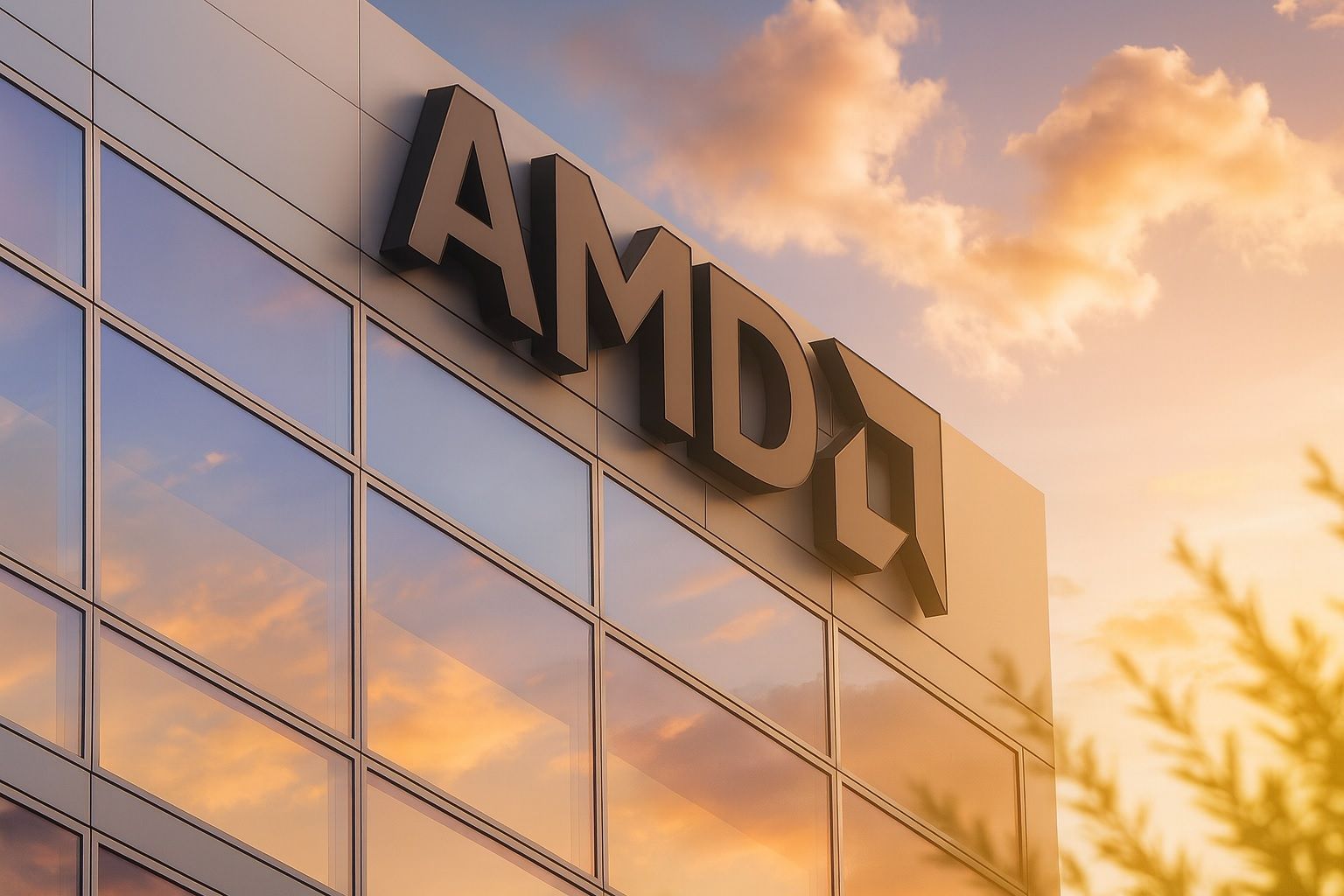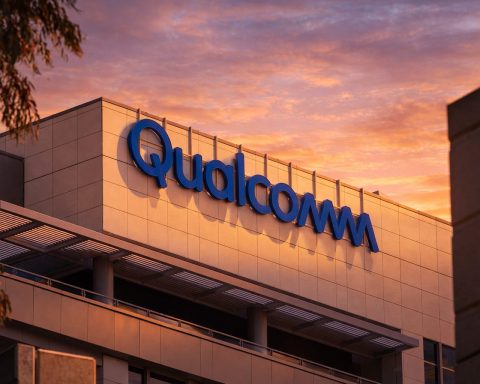- Blistering Rally: AMD stock has surged nearly 80% in 2025, vastly outperforming peers (the semiconductor index is up ~32%) [1]. Shares hit an all-time high last week (~$238.60 on Oct. 15) after explosive gains on AI deal news, before settling around $233 by Friday’s close. Over the past month alone, AMD jumped about 46%, bringing its year-to-date gain to roughly 92% [2]. Broad tech markets are near record highs on AI enthusiasm, lifting AMD’s market cap to about $350 billion [3].
- Blockbuster AI Deals: Two major partnerships have supercharged AMD’s stock. On Oct. 6, AMD announced a multi-year GPU supply deal with OpenAI – a 6-gigawatt order of cutting-edge chips – and granted OpenAI warrants to buy up to ~10% of AMD’s shares at a nominal price [4]. Then on Oct. 14, Oracle Cloud agreed to deploy 50,000 of AMD’s next-gen GPUs in new AI superclusters [5]. AMD expects “more than $100 billion in new revenue” over four years from these and related AI wins [6]. The stock soared 30% on the OpenAI deal and jumped another ~3% on the Oracle news [7] [8].
- Wall Street Gets Bullish: Analysts have raced to raise forecasts. For example, Bank of America’s Vivek Arya just hiked his AMD price target to $300 (from $250) and reiterated a Buy rating, citing “positive announcements at the 2025 OCP Global Summit” that improve visibility into AMD’s upcoming MI450 “Helios” AI hardware platform [9]. Jefferies likewise boosted its target to $300 (from $200) and HSBC to $310 [10]. Wolfe Research upgraded AMD to “Outperform” with a $300 target, saying the company is now on a “conservative path to $10+ earnings power” by 2027 thanks to the OpenAI deal [11]. Around 60–65% of analysts rate AMD a Buy [12], and the average 12-month target has climbed into the mid-$200s – though a few skeptics like Goldman Sachs and Citigroup remain Neutral with targets near $210 [13].
- AI Crown at Stake: AMD’s new deals underscore its ambition in AI chips, but the company is still chasing a dominant rival. NVIDIA currently commands ~90–94% of the AI GPU market [14] [15], and its chips power most large-scale AI models. Intel – long on the sidelines – is now re-entering the race too: at the recent Open Compute Project summit, Intel unveiled a new “Crescent Island” data-center AI chip coming in 2026 as part of a renewed push [16]. (Notably, NVIDIA even took a 4% stake in Intel for $5 billion to co-develop future chips [17].) AMD’s strategy is to offer an “open” alternative to NVIDIA’s proprietary systems, leveraging its Instinct GPUs, EPYC server CPUs, and the just-unveiled “Helios” rack-scale AI platform to win over big cloud players [18] [19]. Oracle, Meta Platforms, and OpenAI are already on board to adopt AMD’s Helios/MI450-based systems once they launch in 2026 [20].
- Valuation & Outlook: AMD’s stock price now reflects lofty expectations. Shares trade around 40× expected 2026 earnings – a rich multiple above even NVIDIA’s (~30×) [21] – and the trailing P/E exceeds 100. High valuations mean little room for error: as TS2.Tech observes, AMD’s current multiples leave “little room for error” if growth falters [22]. The company will report Q3 earnings on November 4, with revenue guidance of ~$8.7 billion (about +20% YoY) [23]. Its last quarter saw record sales ($7.68 billion, +32% YoY) [24], and AMD is targeting ~$33 billion revenue for full-year 2025 [25]. Going into Monday’s session, investors are watching whether AMD can sustain its momentum – and ultimately deliver the AI-fueled growth needed to justify its near-record share price.
Soaring Stock on AI Hype
Advanced Micro Devices has been one of 2025’s star performers on Wall Street. The stock has nearly doubled this year amid a broader tech rally driven by artificial intelligence optimism. As of mid-October, AMD was up roughly 80% year-to-date, far outpacing big peers (for context, NVIDIA was up ~40% YTD and Intel only modestly higher) [26]. This month the gains went parabolic – AMD rocketed from around $165 in early October to over $230 per share, including a single-day +34% spike on Oct. 6 after a major deal announcement [27]. The stock hit a record intraday and closing high around $238 last week (Oct. 15) before cooling slightly into the week’s end. Even so, AMD closed Friday near $233, keeping it “hovering near record levels” going into Monday [28].
This surge comes amid a euphoric backdrop for tech. The Nasdaq and S&P 500 recently notched all-time highs as investors piled into AI-related plays [29]. Chip stocks in particular have been on fire – the Philadelphia Semiconductor Index is up ~32% in 2025 [30]. AMD’s ~$350 billion market capitalization now ranks it the world’s third-largest chipmaker, behind only much-larger rival NVIDIA and longtime competitor Intel [31]. In short, AI fever has propelled AMD into the market’s upper echelon. The question now is whether the company’s fundamentals can catch up to the stock’s rapid ascent.
Blockbuster Deals with OpenAI and Oracle
The catalyst for AMD’s latest leg up was a pair of blockbuster deals that signal big new demand for its chips. First came the OpenAI partnership unveiled on Oct. 6. AMD agreed to supply 6 gigawatts worth of AI GPUs to OpenAI (maker of ChatGPT) over several years – marking one of the largest AI chip orders ever. In a novel twist, OpenAI also secured warrants to purchase up to 160 million AMD shares (around 10% of the company) at a nominal price [32]. Essentially, OpenAI gets a stake in AMD’s upside, aligning both firms’ interests. AMD’s CEO Lisa Su touted the agreement as a “win-win, enabling the world’s most ambitious AI buildout” [33], and CFO Jean Hu said it should “deliver tens of billions of dollars in revenue” and be “highly accretive” to AMD’s earnings over time [34]. OpenAI’s CEO Sam Altman, for his part, welcomed having a second supplier beyond NVIDIA to help scale out OpenAI’s massive AI infrastructure. The stock market’s reaction was unequivocal: AMD shares soared over 30% in one day on the news [35], instantly adding roughly $80 billion to the company’s market value.
Just over a week later, AMD announced another big win – this time with Oracle. On Oct. 14, Oracle Cloud Infrastructure revealed it will deploy 50,000 of AMD’s upcoming Instinct MI450 GPUs in new AI supercluster installations [36]. The rollout is slated to begin in late 2026 and expand in 2027 and beyond [37], dovetailing with when AMD’s next-gen chips (and its new “Helios” rack systems) are expected to be ready. Oracle’s goal is to build out a cutting-edge AI cloud, and it chose AMD as a key partner alongside its existing heavy use of NVIDIA hardware. Oracle touted the AMD alliance as providing “the best price-performance, open, secure, and scalable cloud foundation” for AI workloads [38]. Even in a choppy market, the news gave AMD a pre-market boost – shares jumped about 3% on Oct. 14 while broader indexes struggled [39] [40].
Why are these deals so significant? In short, they validate AMD as an emerging force in artificial intelligence computing. For years, NVIDIA has dominated the AI processor space virtually unchallenged, thanks to its powerful GPUs and software ecosystem. AMD’s share in data-center AI chips has been minimal (low single digits). But OpenAI committing to AMD silicon – and Oracle following suit – signals that top-tier customers see AMD’s AI technology as viable and worth investing in. “Analysts said the OpenAI pact is a major vote of confidence in AMD’s AI chips,” even if NVIDIA still holds a huge lead [41]. Leah Bennett of asset manager Westwood Group (quoted by Reuters) put it succinctly: the OpenAI deal “helps validate [AMD’s] technology” in AI, though she added AMD still “trails NVIDIA for quite some time” in market leadership [42].
Financially, the upside is enormous if AMD executes. AMD itself expects over $100 billion of new revenue in the next four years from the OpenAI/Oracle deals and related opportunities [43] – a staggering figure (for perspective, AMD’s total revenue last year was under $25 billion). Of course, much of that revenue would flow in later years (starting in 2026–27 when the bulk of GPU deliveries occur). In the near term, these announcements don’t suddenly boost this quarter’s sales – but they do improve the long-term growth runway that investors see for AMD. That future promise has been a big reason behind the stock’s surge.
AMD’s Big AI Bet – “Helios” and an Open Ecosystem
Underpinning these deals is AMD’s strategy to differentiate itself against the industry Goliath, NVIDIA. AMD is pitching an “open” alternative in AI infrastructure, in contrast to NVIDIA’s vertically integrated approach. The clearest example of this came at the Open Compute Project (OCP) Global Summit (a major data-center tech conference) held in mid-October. There, AMD showcased its new “Helios” rack-scale AI platform – essentially an all-AMD supercomputer rack design meant for large-scale AI deployments [44]. Helios combines AMD’s Instinct GPUs for AI acceleration, its EPYC CPUs as controllers, and its Pensando networking chips, all tied together with open-standard connectors and software (ROCm). It’s built on an open rack design contributed by Meta (Facebook’s parent) to the OCP community, emphasizing interoperability and easy scaling [45].
In announcing Helios, AMD took direct aim at NVIDIA’s DGX Cloud systems. “Open collaboration is key to scaling AI efficiently,” said Forrest Norrod, head of AMD’s data-center group. With ‘Helios,’ we’re turning open standards into real, deployable systems – combining AMD Instinct GPUs, EPYC CPUs, and open fabrics to give the industry a flexible, high-performance platform built for the next generation of AI workloads.” [46] In practical terms, AMD claims a Helios rack can provide 50% more total memory for AI models than NVIDIA’s upcoming equivalent system [47], thanks to design choices like using 432GB of HBM4 memory per GPU. The open design also promises easier servicing and the ability to mix-and-match components.
For investors, what matters is that major cloud players are interested. Oracle’s 50k-GPU order is effectively a commitment to AMD’s Helios architecture. Meta Platforms is also reportedly evaluating or supporting Helios for its own data centers [48], and of course OpenAI is counting on AMD’s forthcoming MI300X/MI450 chips for its massive compute needs. Bank of America’s analyst Vivek Arya noted these OCP Summit wins as a key reason he’s now more bullish on AMD – it gives “greater visibility into the deployment and ramp outlook” of AMD’s AI hardware in 2026–27 [49]. In his updated model, Arya assumes AMD captures about half of the OpenAI order in that timeframe, which could translate to nearly $10 billion in extra sales by 2027 and annual earnings around $10–11 per share if all goes well [50] [51].
Still, NVIDIA isn’t ceding ground easily. It remains the incumbent with ~90% share of the AI processor market [52]. Its latest GPUs (H100 now, and “Vera Rubin” next-gen coming soon) are entrenched in AI training workloads globally, and NVIDIA has an unparalleled software stack (CUDA, AI libraries) that most AI developers rely on. By investing $5 billion for a stake in Intel, NVIDIA signaled it intends to partner where it makes sense (even with a competitor) to keep its edge – in that case ensuring NVIDIA tech is part of Intel’s future server platforms [53]. Intel, meanwhile, has its own plans: the company’s new CEO has vowed to restart its AI efforts after past missteps. At OCP, Intel announced “Crescent Island,” a forthcoming data-center GPU aimed at AI inference (the deployment of trained AI models) due in 2026 [54] [55]. Intel is taking an “open and modular” approach too – allowing customers to mix its chips with others – and promised to release new AI chips on a yearly cadence like AMD and NVIDIA [56] [57]. All this means competition in AI silicon is heating up from all sides. AMD has momentum now, but it will need to execute superbly to convert its opportunity into a lasting market share gain.
Wave of Upgrades from Wall Street
Following AMD’s deal announcements and product showcase, equity analysts have turned increasingly bullish on the stock. A flurry of research notes in the past two weeks hiked price targets for AMD, in many cases to levels well above the current trading price. The most aggressive calls see AMD approaching the $300 mark within 12 months – which would be another ~30% upside from Friday’s ~$233.
For instance, Jefferies analyst Mark Lipacis (one of the earliest bulls on AMD) raised his target to $300 from $200 after the OpenAI deal, arguing that the deal significantly boosts AMD’s long-term earnings potential [58]. HSBC was even bolder, upping its target to $310 (from $200 prior) on Oct. 15 [59]. Wolfe Research also joined the $300 club – upgrading AMD to Outperform and setting a $300 target while stating the company is now on a “conservative path to $10+ earnings power” by 2027 [60]. That quote implies Wolfe sees AMD earning over $10 per share annually in a couple years (for reference, AMD’s EPS last year was under $3, so that is a big jump forecast). Bank of America’s renowned chip analyst Vivek Arya likewise moved to $300 (from $250) this past week, saying the Open Compute summit gave him more confidence in AMD’s AI roadmap [61]. Arya maintained his “Buy” rating and highlighted how AMD’s Helios platform and MI450 chips, with backing from firms like Meta and Oracle, could ramp revenues strongly in late 2026 and 2027 [62] [63].
All told, AMD now has 30+ analysts with Buy ratings and is considered a “Strong Buy” by the consensus of Wall Street coverage [64]. The average price target across analysts recently climbed to around $250+ [65] (TipRanks pegs the average at ~$250, implying about 7–8% upside from current levels). This average has been moving up as new target increases roll in. A month ago, the consensus was closer to $220. The fact that many high-profile analysts now see a $300 stock price in reach shows how dramatically sentiment has swung in AMD’s favor due to the AI story.
However, it’s worth noting not everyone is all-in on AMD. A few analysts urge caution. For example, Goldman Sachs and Citigroup did not budge from their neutral stances even after the OpenAI deal – both have Hold/Neutral ratings and price targets in the low $200s (~$210) [66], suggesting they believe the stock is already fairly valued or even a bit ahead of itself. These more skeptical voices point to AMD’s rich valuation and execution risks (product delays, competitive responses) as reasons to be careful. As we discuss next, those concerns are not without merit, even as the growth narrative looks compelling.
Frothy Valuation Brings Risks
AMD’s stock price may be in the stratosphere, but ultimately investors will expect the company to deliver commensurate earnings growth to justify it. By traditional metrics, AMD is very expensive right now. After this year’s run, the stock trades around 90 times forward 12-month earnings (and over 100× trailing earnings) [67]. Even looking further out, analysts estimate AMD is priced at about 40× its expected 2026 earnings per share – well above the broader market (S&P 500 is ~20×) and notably higher than NVIDIA’s ~28–30× multiple for 2026 [68] [69]. In other words, the market is already baking in a lot of future growth for AMD, arguably more than it is for NVIDIA (which, for all of AMD’s progress, still has much larger sales and profits today).
Such a premium valuation means any hiccup could trigger a sharp pullback. As one analyst site quipped, AMD’s valuation leaves “little room for error” [70]. The company must execute near-flawlessly on its AI strategy – hitting product launch timelines, scaling up chip production, and securing more big customers – all while fending off NVIDIA and Intel. If AI demand for AMD’s chips ends up slower than anticipated, or if AMD encounters manufacturing bottlenecks (for instance, capacity issues at TSMC, which builds AMD’s chips), investor enthusiasm could cool quickly. AMD is pouring money into R&D and capital expenditures to seize this opportunity – its gross margins have been temporarily dented (~40% last quarter, vs >50% a year prior) by heavy investment and an $800 million inventory buildup for AI chips [71] [72]. That spending should pay off in growth, but it adds execution risk.
Beyond company-specific factors, macro conditions could also weigh on AMD’s high-flying stock. Tech shares have benefited from excitement over AI, but rising interest rates remain a threat – higher bond yields tend to pressure richly valued growth stocks. Geopolitical issues are another wildcard: AMD relies on TSMC in Taiwan to manufacture its most advanced chips, so any escalation in US–China–Taiwan tensions is a risk to its supply chain [73]. The U.S. government’s export controls on advanced chips (aimed at China) also affect AMD – for instance, AMD must sell lower-spec versions of its top AI GPUs in certain markets, potentially limiting some sales [74]. While none of these risks have derailed AMD’s rally yet, they’re factors to keep in mind as the company’s valuation prices in almost perfect outcomes.
For now, the market’s focus is squarely on the AI opportunity and AMD’s brightening prospects. But as history shows, stocks trading on future hype can be volatile. Any hint of a growth slowdown or an earnings miss could bring a swift correction. AMD’s own leadership acknowledges the need to execute rigorously in the coming quarters to fulfill the high expectations riding on the company [75] [76].
Next Up: Earnings and Outlook
Looking ahead, investors won’t have to wait long to get an update on AMD’s current business momentum. AMD is scheduled to report its third-quarter 2025 earnings on November 4. In the wake of the AI deal announcements, this earnings release (and the management commentary) will be closely watched for clues on how the core businesses are faring and how soon the new AI deals might impact financials.
AMD has guided Q3 revenue to be around $8.7 billion, which would be roughly 20% higher than the same quarter last year [77]. That suggests continued strong growth in its data center segment (EPYC server processors) and likely a rebound in client PC chip sales (as the PC market improves). In Q2, AMD impressed with a record $7.68 billion in revenue (+32% YoY) [78], driven by “booming” sales of server and client CPUs. Profitability was decent but not spectacular, as heavy investment in new products trimmed margins. Investors will look for updates on gross margin trajectory – particularly any guidance on when margins might improve as high-cost early-stage AI chip programs (like MI300 series) eventually shift to volume production.
Key things to listen for on Nov. 4: any color on additional AI customer wins, updates on the timeline for delivering chips to OpenAI and Oracle, and management’s outlook for 2026. While the OpenAI and Oracle deals won’t significantly contribute to revenue until late 2026, analysts are eager to hear if demand from other hyperscalers or cloud firms is building now. AMD’s CEO Lisa Su might also discuss the competitive landscape – for example, how AMD views NVIDIA’s new product launches and Intel’s re-entry into AI – as well as any supply chain preparation (TSMC capacity, potential need for further acquisitions or partnerships). The company’s full-year 2025 revenue target of ~$33 billion implies a strong Q4, so an updated outlook there will be telling [79].
For the stock, the earnings report could be a near-term catalyst (one way or the other). A solid beat-and-raise, with upbeat AI commentary, might reinforce the bull case and push AMD shares toward new highs. Conversely, any signs of weakness in current sales or a cautious tone on next year might spur some profit-taking given the stock’s huge run. As always, guidance on future quarters could matter more than the backward-looking results.
Bottom Line
AMD enters the week riding high on optimism that it can play a much bigger role in the AI revolution. The stock’s incredible 2025 rally – capped by landmark deals with OpenAI and Oracle – reflects bullish confidence that AMD’s chips will be powering a significant slice of tomorrow’s AI data centers. Wall Street analysts have dramatically raised their forecasts in kind, and the company itself is projecting robust growth with these new partnerships in hand.
However, current investors are effectively betting on AMD’s execution over the next 1–2 years. The company must translate its pipeline of opportunities into real-world results – delivering new chips on schedule, scaling up production, and continuing to win business in an arena still dominated by a larger competitor. With the stock near record highs and valued richly, any stumble could have outsized consequences for shareholders. As one publication cautioned, AMD’s recent gains mean the stock now “reflects a mix of bullish optimism and steep execution requirements” [80].
In the coming days and months, all eyes will be on whether AMD can meet these sky-high expectations. The first checkpoint arrives with the Nov. 4 earnings report, where management’s commentary on AI initiatives and future growth will be parsed closely. For Monday, October 20, the backdrop is set: AMD is one of the market’s standout performers, armed with game-changing deals and upbeat sentiment. Before the opening bell, investors “in the know” will be digesting all of the above – the spectacular rally, the transformative AI deals, the bullish analyst projections, and the underlying risks – as they decide whether AMD’s stock has more room to run or if it’s time for a breather. The stakes are high, but so is the potential, making AMD a focal point as markets open a new week.
Sources: AMD investor filings and press releases; Reuters and company statements on OpenAI/Oracle deals [81] [82]; TS2.Tech financial analysis [83] [84]; TipRanks, Investing.com and 24/7 Wall St. analyst reports [85] [86] [87].
References
1. ts2.tech, 2. 247wallst.com, 3. ts2.tech, 4. ts2.tech, 5. ts2.tech, 6. ts2.tech, 7. ts2.tech, 8. ts2.tech, 9. www.tipranks.com, 10. ts2.tech, 11. www.investing.com, 12. ts2.tech, 13. ts2.tech, 14. ts2.tech, 15. ts2.tech, 16. ts2.tech, 17. ts2.tech, 18. ts2.tech, 19. www.tomshardware.com, 20. www.tipranks.com, 21. ts2.tech, 22. ts2.tech, 23. ts2.tech, 24. ts2.tech, 25. ts2.tech, 26. ts2.tech, 27. ts2.tech, 28. ts2.tech, 29. ts2.tech, 30. ts2.tech, 31. ts2.tech, 32. ts2.tech, 33. ts2.tech, 34. ts2.tech, 35. ts2.tech, 36. ts2.tech, 37. ts2.tech, 38. ts2.tech, 39. ts2.tech, 40. ts2.tech, 41. ts2.tech, 42. ts2.tech, 43. ts2.tech, 44. www.tomshardware.com, 45. www.tomshardware.com, 46. www.tomshardware.com, 47. www.tomshardware.com, 48. www.tipranks.com, 49. www.tipranks.com, 50. www.tipranks.com, 51. www.tipranks.com, 52. ts2.tech, 53. ts2.tech, 54. www.reuters.com, 55. www.reuters.com, 56. www.reuters.com, 57. www.reuters.com, 58. ts2.tech, 59. ts2.tech, 60. www.investing.com, 61. www.tipranks.com, 62. www.tipranks.com, 63. www.tipranks.com, 64. www.tipranks.com, 65. www.tipranks.com, 66. ts2.tech, 67. ts2.tech, 68. ts2.tech, 69. ts2.tech, 70. ts2.tech, 71. ts2.tech, 72. ts2.tech, 73. 247wallst.com, 74. 247wallst.com, 75. ts2.tech, 76. ts2.tech, 77. ts2.tech, 78. ts2.tech, 79. ts2.tech, 80. ts2.tech, 81. ts2.tech, 82. ts2.tech, 83. ts2.tech, 84. ts2.tech, 85. www.tipranks.com, 86. www.investing.com, 87. 247wallst.com







